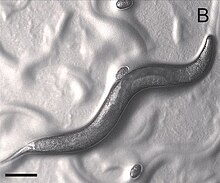Diplogastridae
| Diplogastridae Temporal range:
| |
|---|---|

| |
| Pristionchus pacificus | |
| Scientific classification | |
| Kingdom: | |
| Phylum: | |
| Class: | |
| Subclass: | |
| Superorder: | |
| Order: | |
| Suborder: | |
| Superfamily: | |
| Family: | Diplogastridae Micoletzky 1922
|
| Genera | |
| |
Diplogastridae, formerly Diplogasteridae, are a family of nematodes (roundworms) known from a wide range of habitats, often in commensal or parasitic associations with insects.[1]
Description
Diplogastrid nematodes are characterized by a distinct "two-lobed" pharynx (hence their name from the Greek διπλόος = "double" and γαστήρ = "stomach"), the second (posterior) lobe being composed mostly of glandular tissue. Most known species also have at least one tooth, which has presumably allowed them to access many new food sources compared with the related nematodes of Rhabditidae (including Caenorhabditis elegans), most species of which feed on bacteria. Several diplogastrid species also have a polyphenism in their mouthparts, allowing resource specialization within species. The wide array of feeding modes in Diplogastridae is reflected by the relatively high diversity and complexity of their mouth structures, which show accelerated rates of evolution in comparison with Rhabditidae.[2]
Among Diplogastridae is the nematode Pristionchus pacificus, a model organism for comparative developmental biology.
Genera
- Acrostichus
- Allodiplogaster
- Anchidiplogaster
- Butlerius
- Cephalobium
- Cutidiplogaster
- Demaniella
- Diplogaster
- Diplogasteroides
- Diplogastrellus
- Fictor
- †Formicodiplogaster (Fossil, Dominican Amber[3])
- Goffartia
- Heteropleuronema
- Hugotdiplogaster
- Koerneria
- Leptojacobus
- Levipalatum
- Longibucca
- Mehdinema
- Micoletzkya
- Mononchoides
- Oigolaimella
- Neodiplogaster
- Parapristionchus
- Parasitodiplogaster
- Paroigolaimella
- Pristionchus
- Pseudodiplogasteroides
- Rhabditidoides
- Rhabditolaimus
- Sachsia
- Sudhausia
- Teratodiplogaster
- Tylopharynx
References
- ^ Sudhaus, W.; Fürst von Lieven, A. (2003). "A phylogenetic classification and catalogue of the Diplogastridae (Secernentea, Nematoda)". Journal of Nematode Morphology and Systematics. 6: 43–90.
- ^ Susoy, V.; Ragsdale, E.J.; Kanzaki, N.; Sommer, R.J. (2015). "Rapid diversification associated with a macroevolutionary pulse of developmental plasticity". eLife. 4: e05463. doi:10.7554/eLife.05463. PMID 25650739.
{{cite journal}}: CS1 maint: unflagged free DOI (link) - ^ Poinar, G.O. (2011). "The Evolutionary History of Nematodes: As Revealed in Stone, Amber and Mummies". Nematology monographs and perspectives pages. 9: 91–93, 239–240, 324–325.
